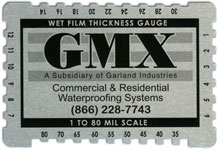
Polymer modified asphalt is approved and specifically referenced as an acceptable waterproofing product in all of the major residential model building codes, provided they are applied at the appropriate thickness, test using a wet film thickness gauge.
International Building Code
IBC § 1806.3.2 Waterproofing Required/Walls
Walls required to be waterproofed shall be concrete or masonry and shall be designed and constructed to withstand the hydrostatic pressures and other lateral loads to which the walls will be subjected.
Waterproofing shall be applied from the bottom of the wall to not less than 12 inches (305mm) above the maximum elevation of the ground water table. The remainder of the wall shall be dampproofed in accordance with Section 1806.2.2. Waterproofing shall consist of two-ply hot mopped felts, not less than 6 mil (.006 inch, .152 mm) polyvinyl chloride, 40-mil (0.040 mil; 1.02 mm) polymer-modified asphalt, 6-mil (.060 mil; 0.152 mm) polyethylene or other approved methods or materials capable of bridging nonstructural cracks. Joints in the membrane shall be lapped and sealed in accordance with the manufacturer's installation instructions.
BOCA National Building Code
1813.4.2.2 Wall Waterproofing Materials
Waterproofing shall be applied from the bottom of the wall to not less than 12 inches (305mm) above the maximum elevation of the ground water table. The remainder of the wall shall be dampproofed in accordance with Section 1813.3.2.2. Waterproofing shall consist of two-ply hot mopped felts, not less than 6 mil (.006 inch, .152 mm) polyvinyl chloride, 40-mil (0.040 mil; 1.02 mm) polymer-modified asphalt, 6-mil (.060 mil; 0.152 mm) polyethylene or other approved methods or materials capable of bridging nonstructural cracks. Joints in the membrane shall be lapped and sealed in accordance with the manufacturer's installation instructions.
Uniform Building Code
Uniform Building Code Appendix Chapter 18, Waterproofing and Dampproofing Foundations, states that when "...hydrostatic pressure caused by water table will not occur, floors and walls shall be dampproofed…" and a subsoil drainage system installed. Otherwise walls and floors must be waterproofed.
UBC 1827.4 Waterproofing Materials
- Rubberized asphalt
- Polymer-modified asphalt
- Butyl rubber
- Other approved materials capable of bridging nonstructural cracks.
Standard Building Code
Standard Building Code Section 1814, Waterproofing and Dampproofing, requires that "…where a groundwater investigation indicates that hydrostatic pressure conditions exist, walls and floors retain earth and enclosing spaces below finished ground level shall be waterproofed… Where hydrostatic conditions do not exist, damproofing and perimeter drainage shall be provided…"
SBC 1814.2.3 Waterproofing
- 3-ply hot mopped felts
- Bentonite clay layer at a minimum 0.75 lb/sq.ft. (3.7 kg/m2)
- 50 mil (1.3 mm) rubberized asphalt sheet or liquid
- 40 mil (1.0 mm) polymer modified asphalt
- 40 mil (1.0 mm) polyurethane rubber
- 20 mil (.5 mm) single ply vulcanized rubber or thermoplastic sheet
- Other approved materials capable of bridging nonstructural cracks.
One and Two Family Dwelling Code
One and Two Family Dwelling Code (OTFDC) Section 406.1 requires waterproofing in "…areas where high water table or other severe soil-water conditions are known to exist…" In other areas, dampproofing is required.
OTFDC 406.2 Concrete and Masonry Foundation Waterproofing
- 2-ply hot mopped felts
- 55 pound (25kg) roll roofing
- 6-mil (0.15 mm) polyvinyl chloride
- 6 mil (0.15 mm) polyethylene
- 40 mil (1.0 mm) polymer modified asphalt
